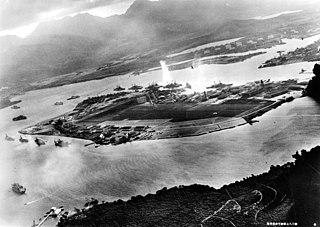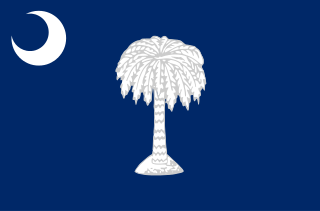USS Timor was purchased at Sag Harbor, New York on 30 October 1861. She was sunk as part of the Stone Fleet at Maffitts channel in Charleston harbor on 25 or 26 January 1862.

The Battle of Cold Harbor was fought during the American Civil War near Mechanicsville, Virginia, from May 31 to June 12, 1864, with the most significant fighting occurring on June 3. It was one of the final battles of Union Lt. Gen. Ulysses S. Grant's Overland Campaign, and is remembered as one of American history's bloodiest, most lopsided battles. Thousands of Union soldiers were killed or wounded in a hopeless frontal assault against the fortified positions of Confederate Gen. Robert E. Lee's army.

The attack on Pearl Harbor was a surprise military strike by the Imperial Japanese Navy Air Service upon the United States against the American naval base at Pearl Harbor in Honolulu, Hawaii, just before 8:00 a.m. on Sunday, December 7, 1941. The United States was a neutral country at the time; the attack led the U.S. to formally enter World War II on the side of the Allies the following day. The Japanese military leadership referred to the attack as the Hawaii Operation and Operation AI, and as Operation Z during its planning.

Husband Edward Kimmel was a United States Navy four-star admiral who was the commander in chief of the United States Pacific Fleet (CINCPACFLT) during the Japanese attack on Pearl Harbor. He was removed from that command after the attack, in December 1941, and was reverted to his permanent two-star rank of rear admiral due to no longer holding a four-star assignment. He retired from the Navy in early 1942. The United States Senate voted to restore Kimmel's permanent rank to four stars in 1999, but President Clinton did not act on the resolution, and neither have any of his successors.

The Virginia Capes are the two capes, Cape Charles to the north and Cape Henry to the south, that define the entrance to the Chesapeake Bay on the eastern coast of North America.

The Battle of Fort Sumter was the bombardment of Fort Sumter near Charleston, South Carolina by the South Carolina militia. It ended with its surrender by the United States Army, beginning the American Civil War.

USS Admirable (AM-136) was the lead ship of her class of minesweeper built for the United States Navy during World War II. In commission from 1943 to 1945, she was transferred to the Soviet Navy in 1945 and served as T-331 until stricken in 1958.

The Overland Campaign, also known as Grant's Overland Campaign and the Wilderness Campaign, was a series of battles fought in Virginia during May and June 1864, in the American Civil War. Lt. Gen. Ulysses S. Grant, general-in-chief of all Union armies, directed the actions of the Army of the Potomac, commanded by Maj. Gen. George G. Meade, and other forces against Confederate Gen. Robert E. Lee's Army of Northern Virginia. Although Grant suffered severe losses during the campaign, it was a strategic Union victory. It inflicted proportionately higher losses on Lee's army and maneuvered it into a siege at Richmond and Petersburg, Virginia, in just over eight weeks.
The second USS Potomac was an old whaler the United States Navy purchased on 1 November 1861. She was a part of the "Stone Fleet," a group of ships used to block the entrances to Confederate harbors during the American Civil War, and was sunk for this purpose on 9 January 1862.

The Battle of Totopotomoy Creek, also called the Battle of Bethesda Church, Crumps Creek, Shady Grove Road, and Hanovertown, was a battle fought in Hanover County, Virginia on May 28–30, 1864, as part of Union Lt. Gen. Ulysses Grant's Overland Campaign against Confederate Gen. Robert E. Lee's Army of Northern Virginia.

Cold Harbor National Cemetery is a United States National Cemetery in Mechanicsville, Hanover County, Virginia. It encompasses 1.4 acres (5,700 m2), and as of the end of 2005, had 2,110 interments. Administered by the United States Department of Veterans Affairs, it is managed by the Hampton National Cemetery.

Sackets Harbor Battlefield State Historic Site is a historically important location in Jefferson County, New York, United States. The historic site is south of the Village of Sackets Harbor, bordering Lake Ontario in the Town of Hounsfield. Two battles were fought near this location during the War of 1812. Some 3,000 men worked at the shipyard building warships, and the village was fortified and garrisoned with thousands of troops.

South Carolina was the first state to secede from the Union in December 1860, and was one of the founding member states of the Confederacy in February 1861. The bombardment of the beleaguered U.S. garrison at Fort Sumter in Charleston Harbor on April 12, 1861, is generally recognized as the first military engagement of the war. The retaking of Charleston in February 1865, and raising the flag again at Fort Sumter, was used for the Union symbol of victory.

Charleston, South Carolina, was a hotbed of secession at the start of the American Civil War and an important Atlantic Ocean port city for the fledgling Confederate States of America. The first shots against the Federal government were those fired there by cadets of the Citadel to stop a ship from resupplying the Federally held Fort Sumter. Three months later, the bombardment of Fort Sumter triggered a massive call for Federal troops to put down the rebellion. Although the city and its surrounding fortifications were repeatedly targeted by the Union Army and Navy, Charleston did not fall to Federal forces until the last months of the war. Charleston was devastated.
USS Peri was one of the ships of the Stone Fleet, sunk in the harbor of Charleston, South Carolina as a blockade during the American Civil War.
The Phoenix was a 404-ton American wooden whaler based in New London, Connecticut. The Union Navy purchased Phoenix at New London on 9 November 1861, at the start of the American Civil War. The Navy wanted her for the Stone Fleet, a group of vessels to be sunk in the channels of important Southern harbors to interrupt Confederate trade. She sailed on the 20th but grounded while crossing Savannah Bar, lost her rudder, and began leaking badly. When refloated she was beached as a breakwater to shelter Union troops landing on Tybee Island, Georgia, on or before 5 December 1861, in preparation for the Battle of Fort Pulaski.
USS Stephen Young was one of the ships of the Stone Fleet, sunk in the harbor of Charleston, South Carolina to be used as a blockade during the American Civil War.
USS Bond (AM-152) was an Admirable-class minesweeper built for the United States Navy during World War II and in commission from 1943 to 1945. In 1945, she was transferred to the Soviet Union and served after that in the Soviet Navy as T-285 and as BRN-37.
The first USS New England was a whaler purchased by the Union Navy at New London, Connecticut, on November 21, 1861.
USS Noble (1861) was a wooden bark purchased during the American Civil War by the Union Navy 2 December 1861 at Sag Harbor, New York.

Project Hula was a program during World War II in which the United States transferred naval vessels to the Soviet Union in anticipation of the Soviets eventually joining the war against Japan, specifically in preparation for planned Soviet invasions of southern Sakhalin and the Kuril islands. Based at Cold Bay in the Territory of Alaska, the project was active during the spring and summer of 1945. It was the largest and most ambitious transfer program of World War II.
This article incorporates text from the public domain Dictionary of American Naval Fighting Ships .The entry can be found here.